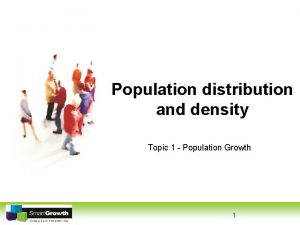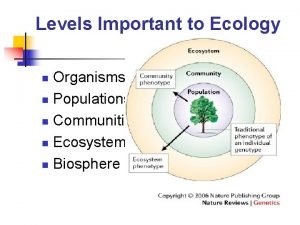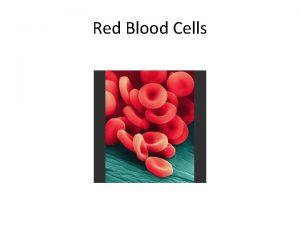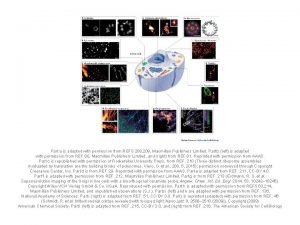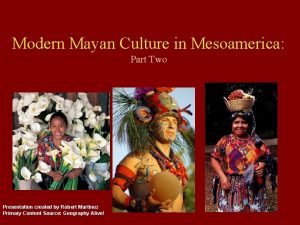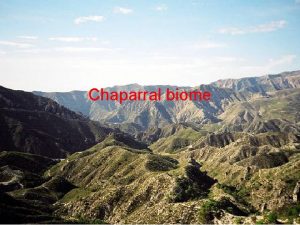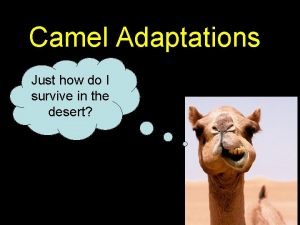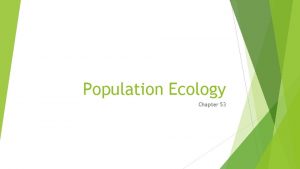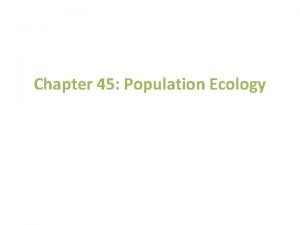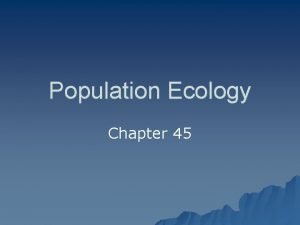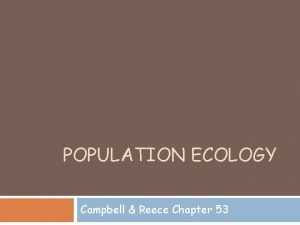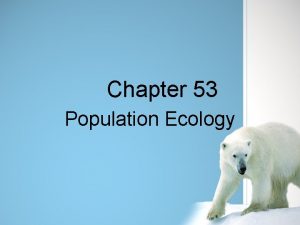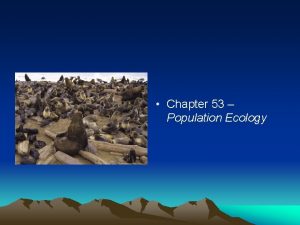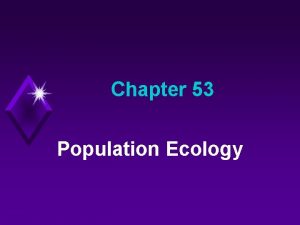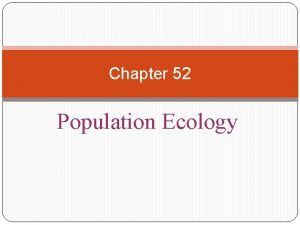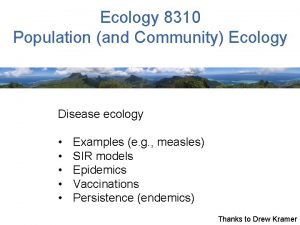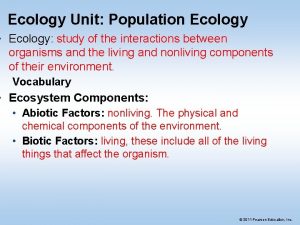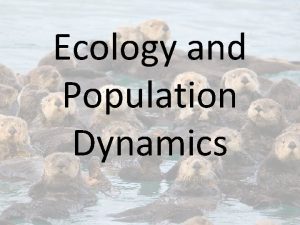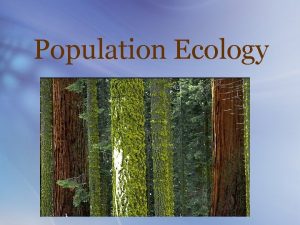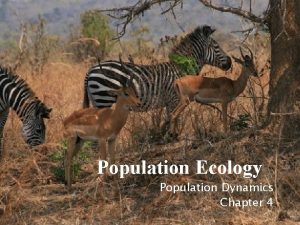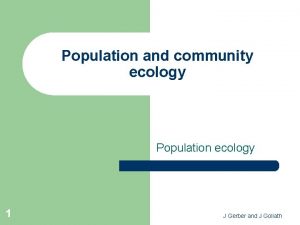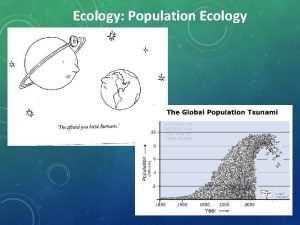Chapter 53 POPULATION ECOLOGY Adapted from Mrs Chous
































- Slides: 32

Chapter 53 POPULATION ECOLOGY Adapted from Mrs. Chou’s presentation

Ch. 53 Vocabulary Define: Demography Semelparity Iteroparity Carrying capacity Exponential growth curve Logistic growth curve K-selection r-selection Ecological footprint

You Must Know: • How density, dispersion, and demographics can describe a population. • The differences between exponential and logistic models of population growth. • How density-dependent and densityindependent factors can control population growth.

Introduction • Population = group of individuals of a single species living in same general area • Density: # individuals / area • Dispersion: pattern of spacing between individuals

Determining population size and density: • Count every individual • Random sampling • Mark-recapture method

Patterns of Dispersal: 1. Clumped – most common; near required resource 2. Uniform – usually antagonistic interactions 3. Random – unpredictable spacing, not common in nature

Demography: the study of vital statistics of populations and how they change over time • Additions occur through birth, and subtractions occur through death. • Life table: age-specific summary of the survival pattern of a population

Survivorship Curve: represent # individuals alive at each age • Type I: low death rate early in life (humans) • Type II: constant death rate over lifespan (squirrels) • Type III: high death rate early in life (oysters)

Change in Population Size = Births during time interval - Deaths during time interval

Zero Population Growth

Population Growth Models

Exponential population growth: ideal conditions, population grows rapidly

Exponential Growth Equation d. N/dt = change in population r = growth rate of pop. N = population size

Exponential Growth Problem Sample Problem: A certain population of mice is growing exponentially. The growth rate of the population (r) is 1. 3 and the current population size (N) is 2, 500 individuals. How many mice are added to the population each year?

• Unlimited resources are rare! • Logistic model: incorporates carrying capacity (K) • K = maximum stable population which can be sustained by environment

Logistic Growth Equation d. N/dt = change in population r = growth rate of pop. N = population size K = carrying capacity

Logistic Growth Problem Sample Problem: If a population has a carrying capacity (K) of 900, and the growth rate (r) is 1. 1, what is the population growth when the population (N) is 425?

Life History: traits that affect an organism’s schedule of reproduction and survival 3 Variables: 1. Age of sexual maturation 2. How often organism reproduces 3. # offspring produced per reproductive episode Note: These traits are evolutionary outcomes, not conscious decisions by organisms

Semelparity • Big-bang reproduction • Many offspring produced at once • Individual often dies afterwards • Less stable environments Agave Plant

Semelparity • Big-bang reproduction • Many offspring produced at once • Individual often dies afterwards • Less stable environments Salmon Spawning https: //www. youtube. com/watch? v=YZPHrl 4 ICm 0


Iteroparity • Repeated reproduction • Few, but large offspring • More stable environments Lizards Perennial Plants Birds Mammals Insects

Current hypothesis suggests two critical factors contribute to the evolution of semelparity and iteroparity: • Survival rate of offspring • Likelihood adult will survive to reproduce again Semelparity Unpredictable environment/low survival rate for offspring & adults Iteroparity More stable environment/higher survival rate for offspring & adults Many life histories are intermediate between the two extremes!

• K-selection: pop. close to carrying capacity • r-selection: maximize reproductive success K-selection r-selection Live around K Exponential growth High prenatal care Little or no care Low birth numbers High birth numbers Good survival of young Poor survival of young Density-dependent Density independent ie. Humans ie. cockroaches

Factors that limit population growth: • Density-Dependent factors: population matters • i. e. Predation, disease, competition, territoriality, toxic wastes, physiological factors • Density-Independent factors: population not a factor • i. e. Natural disasters: fire, flood, weather

Density-Dependent Regulation

Population Dynamics • Population fluctuations due to biotic & abiotic factors 1975 -1980: peak in wolf numbers 1995: harsh winter weather (deep snow)

What do you notice about the population cycles of the showshoe hare and lynx?

Boom-and-bust cycles • Predator-prey interactions • Eg. lynx and snowshoe hare on 10 -year cycle

Age-Structure Diagrams

Human Population Growth • 2 configurations for a stable human population (zero population growth): A. High birth / high death B. Low birth / low death • Demographic transition: occurs when population goes from A B

Global Carrying Capacity • Current world population (2017) = 7. 7 billion https: //www. worldometers. info/world-population/ • Estimated carrying capacity = 10 -15 billion? • Ecological footprint: total land + water area needed for all the resources a person consumes in a pop. • 1. 7 hectares (ha)/person is sustainable • Typical person in U. S. = 10 ha footprint Limitations? Consequences? Solutions?
 Mrs chous ap biology
Mrs chous ap biology Chapter 4 section 1 population dynamics answer key
Chapter 4 section 1 population dynamics answer key Chapter 4 section 1 population dynamics
Chapter 4 section 1 population dynamics Section 1 population dynamics answer key
Section 1 population dynamics answer key Population ecology section 1 population dynamics
Population ecology section 1 population dynamics Chapter 53 population ecology
Chapter 53 population ecology Chapter 36 population ecology
Chapter 36 population ecology Ecology
Ecology Chapter 53 population ecology
Chapter 53 population ecology Chapter 4 population ecology answer key
Chapter 4 population ecology answer key Chapter 53 population ecology
Chapter 53 population ecology Logistic growth ecology definition
Logistic growth ecology definition Logistic and exponential growth
Logistic and exponential growth Ecology
Ecology Population vs community ecology
Population vs community ecology Concept 3 population ecology
Concept 3 population ecology Survivorship curve def
Survivorship curve def Characteristics of population ecology
Characteristics of population ecology Population characteristics
Population characteristics What is population ecology
What is population ecology Population definition ecology
Population definition ecology Population ecology
Population ecology Parasitism
Parasitism They are mrs garcia and mrs castro
They are mrs garcia and mrs castro They are mrs garcia and mrs castro
They are mrs garcia and mrs castro Mrs. darling was ___________ of mrs. s.
Mrs. darling was ___________ of mrs. s. This passage is adapted from jane austen
This passage is adapted from jane austen How is a red blood cell adapted
How is a red blood cell adapted Adapted with permission from
Adapted with permission from In what ways have the highland maya adapted to modern life?
In what ways have the highland maya adapted to modern life? Adaptations of xerophytes
Adaptations of xerophytes Chaparral biomass
Chaparral biomass 5 adaptive features of camel
5 adaptive features of camel





















